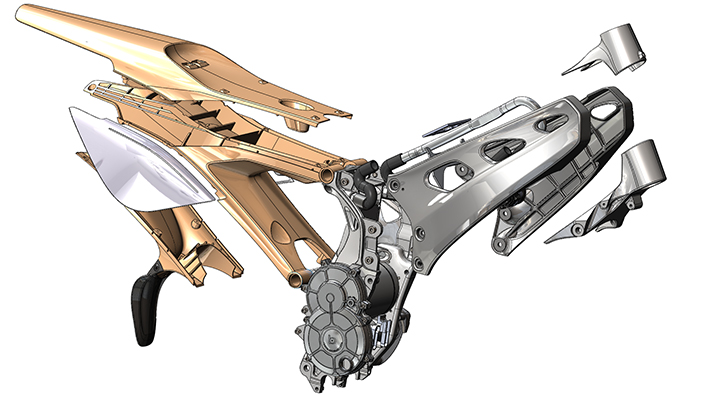A smooth, perfectly responsive torque curve – with no gaps when the bike upshifts or downshifts – has long been the dream of motorcycle riders. A group of motorcycle enthusiasts from California has established a company to produce electric bikes for the mainstream market that turns this dream into a reality.
When co-founders Marc Fenigstein (chief executive officer), Derek Dorresteyn (chief technology officer), and Jeff Sand (chief design officer), founded Alta Motors in 2010, their goal was simply to design a better-performing motorcycle. Dorresteyn and Sand had wrestled with the challenge of providing full torque whenever a rider needs it, spending nights and weekends exploring what’s possible. They eventually realised that supplying torque on demand requires elimination of the bike’s gearbox and use of an electric-drive motor. With that initial idea, Alta Motors was born.
“Jeff and I really liked the concept of electric off-road motorcycles capable of outperforming the gas counterparts,” Dorresteyn recalls. “What started off as a hobby in our spare time gained mass, gravity, and momentum. Before we knew it, the work became a full-time job with the establishment of Alta Motors.”

The company’s first order of business was to quickly and cost-effectively develop a functioning prototype. Using this demonstration motorcycle, Alta could attract capital investment and establish a dealer network. To overcome the technical challenges associated with this innovative concept, Alta needed a robust product development solution.
Dorresteyn and Sand had worked in design and engineering for years, so they were familiar with 3D CAD systems. “Back in 1996, I was evaluating Pro/ENGINEER® and Unigraphics® software when I heard about a more user-friendly 3D modeller called SOLIDWORKS®,” Sand recalls. “I was the seventh customer on the West Coast.”
“Jeff tuned me into it,” Dorresteyn adds. “I brought SOLIDWORKS into the curriculum at the California College of the Arts in 1998, and SOLIDWORKS has been my primary CAD system ever since.”
Alta chose the SOLIDWORKS product development suite because the solutions are easy to use, fully integrated, and extremely capable. The company has implemented SOLIDWORKS Professional design, SOLIDWORKS Premium engineering, SOLIDWORKS Simulation Premium finite element (FEA) analysis, SOLIDWORKS Flow Simulation computational fluid dynamics (CFD) analysis, and SOLIDWORKS Enterprise PDM product data management software.
Reinventing the performance motorcycle
SOLIDWORKS solutions help Alta achieve its vision of making motorcycles that redefine the term “performance.” Unlike other electric motorcycle companies that focus on the limited markets associated with racing bikes, Alta is creating electric bikes for mainstream motorcycle consumers because their bikes outperform the gas-powered equivalents.
“We set out to make motorcycles that perform better,” Sand explains. “The best applications for an electric drive are the smaller dirt and street bikes. There are potentially tens of thousands of customers interested in buying the motocross and street legal electric bikes that we’ve developed with SOLIDWORKS for one simple reason: they’re better than gas bikes.”
Leveraging simulation horsepower
Alta heavily leveraged SOLIDWORKS Simulation tools to overcome technical challenges and improve the performance of its Red Shift preproduction models. For example, with SOLIDWORKS Simulation Premium structural analysis capabilities, Alta eliminated one-third of the mass of its initial design and made the chassis 10% stronger— while improving manufacturability. The company also used SOLIDWORKS Flow Simulation software to optimise the water-cooling system that maintains the optimal heat balance inside the bike’s battery pack.

Using SOLIDWORKS Simulation tools, Alta Motors overcame technical challenges while improving motorcycle performance, such as eliminating a third of the design’s mass and shaving off an additional 10% of its weight, resulting in increased strength
“SOLIDWORKS Simulation Premium really helped us address a range of structural issues related to reducing weight while maintaining structural integrity and safety,” Sand notes. “We ran lots of optimisation loops to take mass out of the vehicle. The SOLIDWORKS analysis tools enabled us to reach a design that is lighter, stronger, and less expensive to produce.”
Eliminating hundreds of prototypes
Because Alta uses SOLIDWORKS Simulation Premium and SOLIDWORKS Flow Simulation software to fully simulate design behaviour and improve performance, the company has eliminated hundreds of rounds of prototyping. “Parts of our bike required numerous iterations and micro-iterations,” Dorresteyn says. “Doing our testing virtually with SOLIDWORKS simulation literally saved hundreds of part prototypes and one or two complete prototype builds.”
“With all its integrated tools and capabilities, we believed SOLIDWORKS would get us all the way through development and help us achieve our goal,” Sand adds. “You get a lot of horsepower with SOLIDWORKS, and we know we can rely on it to create bikes that are simply faster.”
Want the best engineering stories delivered straight to your inbox? The Professional Engineering newsletter gives you vital updates on the most cutting-edge engineering and exciting new job opportunities. To sign up, click here.
Content published by Professional Engineering does not necessarily represent the views of the Institution of Mechanical Engineers.